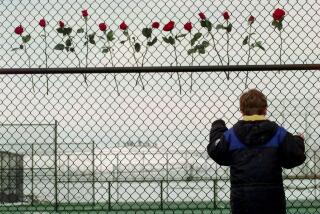The End of Innocence
- Share via
Monday’s announcement that police had charged two Chicago boys, 7 and 8, with murdering an 11-year-old girl and Tuesday’s sentencing of 12- and 14-year-old boys for killing five people in a Jonesboro, Ark., schoolyard have left many Americans wondering whatever became of childhood innocence.
Police said the two boys in Chicago had been angling to steal the bright-blue bicycle that Ryan Harris was riding. In another era they might have taken the bike and fled, but on July 27 they allegedly hit Ryan with a rock, then asphyxiated and sexually abused her.
President Clinton has called the Jonesboro shooting, along with a string of other recent murders by children that began last October in Pearl, Miss., “more than isolated incidents.” There is no evidence linking these crimes to what the president calls “a changing culture that desensitizes our children to violence.” But it is clear that the number of juveniles committing violent crimes nearly doubled between 1988 and 1996, before a slight downturn.
The crimes in Chicago and Jonesboro have left authorities scrambling to protect society from children too young to incarcerate in existing facilities. Though Illinois judges aren’t allowed to commit children under 10 to juvenile prisons, child welfare workers do have the authority to place children in locked psychiatric facilities until they turn 21. In Arkansas, state authorities will be able to hold the two boys in youth detention camp until they turn 18, but they will have to build new facilities to keep them in jail between 18 and when their maximum sentences end at age 21.
The rise in violent juvenile crime underscores the need for parents, teachers, judges, social workers and others to find better ways of intervening early in the lives of troubled children in an effort to head off violence. The budget that cleared the California Legislature Tuesday embraces one promising concept; it allocates a record $50 million for after-school programs aimed at keeping kids occupied between 3 and 8 p.m., the hours when juvenile crime peaks.
Ultimately, however, a troubling question remains with us. Why are children, who used to only quarrel or push and shove, now capable of murder? The answers are not to be found in Sacramento or in Washington. They are not to be found in excuses about socioeconomic background, for children of every strata have been accused of heinous crimes. The answers lie in how we raise our children, whether we inculcate in them a sense of honor and justice, and how well we protect them from pernicious influences. It’s that complex and it’s that simple.
More to Read
Sign up for Essential California
The most important California stories and recommendations in your inbox every morning.
You may occasionally receive promotional content from the Los Angeles Times.













